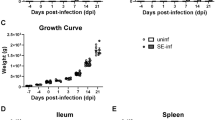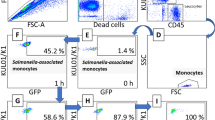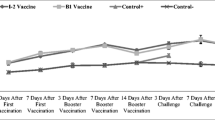Abstract
Investigations in our laboratories have indicated that an increased resistance to SE organ infectivity in chicks was conferred by the immunoprophylactic administration of SE-immune lymphokines (SE-ILK). This resistance was associated with an increase in the lamina propria thickness due to a marked infiltration of inflammatory polymorphonuclear cells (PMNs). In the present study, we determined whether the hematological profile of SE-ILK-treated chicks might reflect changes that are associated with the protection against organ invasion by SE. As protection has been observed in previous studies within 24 h of SE-ILK administration, we evaluated alterations in the circulating leukocyte profile in 1-day-old Leghorn chicks during this time period. We also determined whether the alterations in the peripheral blood leukocytes correlated with the increased protection against SE organ invasion induced by the SE-ILK. Within 4 h after an intraperitoneal injection of SE-ILK and challenge with SE, the number of circulating leukocytes increased significantly (P < 0.05) from all of the other treatment groups. The number of circulating PMNs was found to account for more than 80% of the increase in the number of circulating leukocytes. Using correlation analysis, we found a strong association between the number of circulating PMNs and the protection induced by SE-ILK against SE organ invasion. These studies associate the expansion of the available pool of circulating PMNs and the expression of innate resistance to organ invasion by SE.
Similar content being viewed by others
References
U.S.Department of Agriculture, Agricultural Research Service. 1989. Report of theSalmonella enteritidis task force for research. 1–34.
Tellez, G. I., M. H. Kogut, andB. M. Hargis. 1993. Immunoprophylaxis ofSalmonella enteritidis (SE) infection by lymphokines in Leghorn chicks.Avian Dis. 37:1062–1070.
McGruder, E. D., P. M. Ray, G. I. Tellez, M. H. Kogut, D. E. Corrier, J. R. DeLoach, andB. M. Hargis. 1993.Salmonella enteritidis (SE) immune cytokines: Effect on increased resistance to SE organ invasion in day-old Leghorn chicks.Poult. Sci. 72:2264–2271.
Kogut, M. H., G. I. Tellez, B. M. Hargis, D. E. Corrier, andJ. R. DeLoach. 1993. The effect of 5-fluorouracil treatment of chicks: A cell depletion model for the study of avian polymorphonuclear leukocytes and natural host defenses.Poult. Sci. 72:1873–1880.
Ulich, T. R. 1992. Hematological effects of cytokines in vivo.In Cytokines in Health and Disease. S. L. Kunkel and D. G. Remick, editors. Marcel Decker, New York. 235–256.
Rose, M. E., P. Hesketh, andB. M. Ogilvie. 1979. Peripheral blood leukocyte response to coccidial infection: A comparison of the response in rats and chickens and its correlation with resistance to reinfection.Immunology 36:71–79.
Kogut, M. H., andP. L. Long. 1984. The peripheral blood leukocyte response of chickens and turkeys infected with turkey embryo adapted strains ofEimeria tenella andE. necatrix.Exp. Parasitol. 58:63–71.
Golemboskie, K. A., S. E. Bloom, andR. R. Dietert. 1990. Dynamics of avian inflammatory response to cross-linked dextran. Changes in avian blood leukocyte populations.Inflammation 14:31–40.
Latimer, K. S., K.-N. Tang, M. A. Goodwin, W. L. Steffens, andJ. Brown. 1988. Leukocyte changes associated with acute inflammation in chickens.Avian Dis. 32:760–772.
Andrews, W., P. Poelma, C. Wilson, andA. Romero. 1978. Isolation and identification ofSalmonella.In Bacteriological Analytical Manual, 5th ed. Association of Official Analytical Chemists, Washington, D.C. 1–29.
National Research Council. 1984. Nutrient Requirements of Poultry, 8th rev. ed. National Academy Press, Washington, D.C.
Kogut, M. H., andT. Slajchert. 1992. T lymphocytes induce protection in chickens againstEimeria tenella by the production of lymphokines.Immunol. Infect. Dis. 2:69–80.
Julius, M. H., E. Simpson, andA. Herzenberg. 1973. A rapid method for the isolation of functional thymus derived murine lymphocytes.Eur. J. Immunol. 3:645–653.
Freshney, R. I. 1983. Culture of Animal Cells, Vol. 1. Alan R. Liss, New York.
Weiler, H., andW. Von Bulow. 1987. Development of optimal conditions for lymphokine production by chicken lymphocytes.Vet. Immunol. Immunopathol. 14:257–267.
Natt, M. P., andC. A. Herrick. 1952. A new blood diluent for counting the erythrocytes and leukocytes of the chicken.Poult. Sci. 31:735–738.
Lucas, A. M., andC. Jamroz. 1961. Atlas of Avian Hematology. USDA, Washington, D.C. 155–156.
U.S. Department of Agriculture, Animal and Plant Health Inspection Service. 1989. National poultry improvement plan and auxiliary provisions. Veterinary Services, Publication APHIS 91-40. U.S. Government Printing Office, Washington, D.C.
SAS Institute. 1982. SAS Users Guide: Statistics. SAS Institute, Inc., Cary, North Carolina.
Zar, J. 1984. Biostatistical Analysis, 2nd ed. Prentice-Hall, Englewood Cliffs, New Jersey. 384–351.
Luginbuke, R. C., andS. D. Schlotzhaver. 1987. SAS/STAT guide for Personal Computers, 6th ed. SAS Institute, Cary, North Carolina, 555–573.
Czuprynski, C. J., P. M. Henson, andP. A. Campbell. 1985. Enhanced accumulation of inflammatory neutrophils and macrophages mediated by transfer of T cells from mice immunized withListeria monocytogenes.J. Immunol. 134:3449–3454.
Kratz, S. S., andR. J. Kurlander. 1988. Characterization of the pattern of inflammatory cell influx and cytokine production during the murine host response toListeria monocytogenes.J. Immunol. 141:598–606.
Czuprynski, C. J., andJ. R. Brown. 1987. Dual regulation of anti-bacterial resistance and inflammatory neutrophil and macrophage accumulation by L3T4+ and Lyt 2+ Listeria-immune T cells.Immunology 60:287–293.
Gross, W. B. 1961. Blood cultures, blood counts, and temperature records in an experimentally produced “air sac disease” and uncomplicatedEscherichia coli infection of chickens.Poult. Sci. 41:691–709.
Glick, B., andC. Rosse. 1976. Cellular composition of the bone marrow in the chicken. Identification of cells.Anat. Rec. 185:235–246.
Ficken, M. D., J. F. Edwards, andJ. C. Lay. 1986. Induction, collection, and partial characterization of induced respiratory macrophages of the turkey.Avian Dis. 30:766–771.
Rose, M. E., andP. Hesketh. 1974. Fowl peritoneal exudate cells: Collection and use for the macrophage migration test.Avian Pathol. 3:297–304.
Toth, T. E., P. B. Siegel, andH. Veit. 1987. Cellular defense of the avian respiratory system. Influx of phagocytes, elicitation versus activation.Avian Dis. 31:861–867.
Metcalf, D. 1986. The molecular biology and functions of granulocyte-macrophage colony stimulating factors.Blood 67:257–267.
McNiece, I. K. 1992. Structure and function of interleukin-3, erythropoietin, and the colonystimulating factors.In Cytokines in Health and Disease. S. L. Kunkel and D. G. Remick, editors. Marcel Dekker, New York. 61–78.
Ihle, J. N. 1990. Lymphokine regulation of hematopoietic cell development.In Immunophysiology. The Role of Cells and Cytokines in Immunity and Inflammation. J. J. Oppenheim and E. M. Shevach, editors. Oxford University Press, New York. 166–193.
Ruskin, J., andJ. Remington. 1969. Role of the macrophage in acquired immunity to phylogenetically diverse intracellular organisms.J. Immunol. 103:252–259.
Simon, H. B., andJ. Sheargren. 1972. Enhancement of macrophage bactericidal capacity by antigenically stimulated lymphocytes.Cell. Immunol. 4:163–174.
Takeuchi, A., andH. Sprinz. 1967. Electron microscope studies of experimentalSalmonella infections in the preconditioned guinea pig. II. Response of the intestinal mucosa to the invasion bySalmonella typhimurium.Am. J. Pathol. 51:137–146.
Wolfe, S. A., D. E. Tracy, andC. S. Henney. 1976. Induction of natural killer cells by BCG.Nature 262:584–586.
Conlon, J. W., andR. J. North. 1992. Early pathogenesis of infection in the liver with the facultative intracellular bacteriaListeria monocytogenes, Francisella tularensis, andSalmonella typhimurium involves lysis of infected hepatocytes by leukocytes.Infect. Immun. 60:5164–5171.
Hart, P. H., L. K. Spencer, A. Nikoloutsopoulos, A. F. Lopez, M. A. Vadas, P. J. McDonald, andJ. J. Finlay-Jones. 1986. Role of cell surface receptors in the regulation of intracellular killing of bacteria by murine peritoneal exudate neutrophils.Infect. Immun. 52:245–251.
Lin, F.-R., X.-M. Wang, H. S. Hsu, V. R. Mumaw, andI. Naconecza. 1987. Electron microscopic studies on the location of bacterial proliferation in the liver in murine salmonellosis.Br. J. Exp. Pathol. 68:539–550.
Beckerdite, S., C. Mooney, J. Weiss, R. Franson, andP. Elsbach. 1974. Early and discrete changes in permeability ofE. coli and other gram negative bacteria during killing by granulocytes.J. Exp. Med. 140:396–409.
Miller, R. M., J. Garbus, andR. B. Hornick, 1972. Lack of enhanced oxygen consumption by PMN leukocytes in phagocytosis of virulentSalmonella typhii.Science.175:1010–1011.
Rossack, R. E., R. L. Guerrant, P. Densen, J. Schadelin, andG. L. Mandell. 1981. Diminished neutrophil oxidative metabolism after phagocytosis of virulentSalmonella typhii.Infect. Immun. 31:674–678.
Stabler, J., T. C.McCormick, K. C.Powell, and M. H.Kogut. 1993. Avian heterophils and monocytes: phagocytic and bactericidal activities againstSalmonella enteritidis. Vet. Microbiol. (in press).
Nauciel, C., andF. Espinasse-Maes. 1992. Role of gamma interferon and tumor necrosis factor alpha in resistance toSalmonella typhimurium infection.Infect. Immun. 60:450–454.
Mastroeni, P., A. Arena, G. B. Costa, M. C. Liberto, L. Bonina, andC. E. Hormaeche. 1991. Serum TNF in mouse typhoid and enhancement of a salmonella infection by anti-TNF antibodies.Microb. Pathogen. 11:33–38.
Morrissey, P. J., andK. Charrier. 1991. Interleukin-1 administration to C3H/HeJ mice after but not prior to infection increase resistance toSalmonella typhimurium.Infect. Immun. 59:4729–4731.
Muotiala, A., andP. H. Makela. 1990. The role of IFN in murineSalmonella typhimurium infection.Microb. Pathogen. 8:135–141.
Nakano, Y., K. Onozuka, Y. Terada, H. Shinomiya, andM. Nakano. 1990. Protective effect of recombinant tumor necrosis factor in murine salmonellosis.J. Immunol. 144:1935–1941.
Tite, J. P., G. Dougan, andS. N. Chatfield. 1991. The involvement of tumor necrosis factor in immunity toSalmonella infection.J. Immunol. 147:3161–3164.
Edwards, C. K., S. M. Ghiasuddin, L. M. Yunger, R. M. Lorence, S. Arkins, R. Danzer, andK. W. Kelley. 1992. In vivo administration of recombinant growth hormone or gamma interferon activates macrophages: Enhanced resistance to experimentalSalmonella typhimurium infection is correlated with generation of reactive oxygen intermediates.Infect. Immun. 60:2514–2521.
Liu, Z., R. J. Simpson, andC. Cheers. 1992. Recombinant interleukin-6 protects mice against experimental bacterial infection.Infect. Immun. 60:4402–4406.
Cheers, C., Y. F. Zhan, andP. J. Egan. 1990. In vivo IL-1 potentiates both specific and non-specific arms of immune response to infection.Immunology 70:411–413.
Haak-Frendscho, M., K. M. Young, andC. J. Czuprynski. 1990. Treatment of mice with human recombinant interleukin-2 augments resistance to the facultative intracellular pathogenListeria monocytogenes.Infect. Immun. 57:3014–3021.
Fortier, A. H., T. Polsinelli, S. J. Green, andC. A. Nacy. 1992. Activation of macrophages for destruction ofFrancisella tularensis: Identification of cytokines, effector cells, and effector molecules.Infect. Immun. 60:817–825.
Leiby, D. A., A. H. Fortier, R. M. Crawford, R. D. Schreiber, andC. A. Nacy. 1992. In vivo modulation of the murine immune response toFrancisella tularensis LVS by administration of anticytokine antibodies.Infect. Immun. 60:84–89.
Morrissey, P. J., andK. Charrier. 1990. GM-CSF administration augments the survival of ity-resistant A/J mice, but not ity-susceptible C57BL/6 mice, to a lethal challenge withSalmonella typhimurium.J. Immunol. 144:557–561.
Shinomiya, N., S. Tsuru, Y. Katsura, S. Kayashima, andK. Nomoto. 1991. Enhanced resistance againstListeria monocytogenes achieved by pretreatment with granulocyte colonystimulating factor.Infect. Immun. 59:4740–4743.
Serushago, B. A., Y. Yoshikai, T. Handa, M. Mitsuyama, K. Muramori, andK. Nomoto. 1992. Effect of recombinant human granulocyte colony-stimulating factor (rh G-CSF) on murine resistance againstListeria monocytogenes.Immunology 75:475–480.
Author information
Authors and Affiliations
Rights and permissions
About this article
Cite this article
Kogut, M.H., McGruder, E.D., Hargis, B.M. et al. Dynamics of avian inflammatory response toSalmonella-immune lymphokines. Inflammation 18, 373–388 (1994). https://doi.org/10.1007/BF01534435
Issue Date:
DOI: https://doi.org/10.1007/BF01534435




